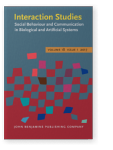Prelinguistic gesture use in mother-infant and mother-infant-sibling interactions
I tested the hypothesis that, in infant-mother-sibling interactions, infants with older siblings aged 11 to 24
months produce deictic gestures when they are proximal to, or engaging in joint attention with, their mothers more frequently than same-aged
infants without siblings. Fifteen infant-mother dyads and 10 infant-mother-sibling triads were individually observed for 15 minutes in a
playroom full of toys. Infants involved in infant-mother-sibling interactions produced more deictic gestures when they were proximal to
their mothers than infants in infant-mother interactions. Further, infants involved in infant-mother-sibling interactions accompanied their
gestures with vocalizations at a higher rate than infants in infant-mother interactions. This result suggests that infants with older
siblings monitor their mothers more carefully in interactions in which their sibling is also present, and that they produce deictic gestures
in order to effectively elicit joint action with their mothers.
Article outline
- 1.Introduction
- 2.Methods
- 2.1Participants
- 2.2Apparatus and data collection
- 2.3Data coding
- 2.4Data analysis
- 3.Results
- 3.1Frequency of deictic gestures produced by infants
- 3.2Deictic gestures with vocalization
- 3.3Proximity to mother and joint attention
- 3.4Proximity, joint attention, and the frequency of deictic gestures
- 3.5Observed/expected frequency ratios of deictic gestures for infants with and without older siblings
- 3.6Observed/expected frequency ratios of deictic gestures accompanied by vocalization for infants with and without older siblings
- 3.7The effect of proximity and joint attention on observed/expected frequency ratios
- 3.8Additional analyses on infants with older siblings
- 4.Discussion
- Acknowledgments
- Notes
-
References
This article is currently available as a sample article.
References (21)
Benigno, J. P., Clark, L., & Farrar, M. J
(
2007)
Three is not always a crowd: Contexts of joint attention and language.
Journal of Child Language, 34(1), 175–187.


Butterworth, G
(
2003)
Pointing is the royal road to language for babies. In
S. Kita (Ed.),
PointingPointing: Where language, culture, and cognition meet (pp. 9–33). Mahwah, NJ: Erlbaum.

Emery, N. J
(
2000)
The eyes have it: the neuroethology, function and evolution of social gaze.
Neuroscience & Biobehavioral Reviews, 24(6), 581–604.


Fleiss, J. L., Levin, B., & Paik, M. C
(
2003)
Statistical methods for rates and proportions (3rd ed.). Hoboken, NJ: Wiley & Sons.


Franco, F
(
2005)
Infant pointing: Harlequin, servant of two masters. In
N. Eilan,
C. Hoerl,
T. McCormack, &
J. Roessler (Eds.),
Joint attention: Communication and other minds. Issues in philosophy and psychology (pp. 129–164). Oxford: Oxford University Press.


Goldin-Meadow, S., Goodrich, W., Sauer, E., & Iverson, J
(
2007)
Young children use their hands to tell their mothers what to say.
Developmental Science, 10(6), 778–785.


Gräfenhain, M., Behne, T., Carpenter, M., & Tomasello, M
(
2009)
One-year-olds’ understanding of nonverbal gestures directed to a third person.
Cognitive Development, 24(1), 23–33.


Jones, C. P., & Adamson, L. B
(
1987)
Language use in mother-child and mother-child-sibling interactions.
Child Development, 58(2), 356–366.


Krueger, J
(
2011)
Extended cognition and the space of social interaction.
Consciousness and Cognition, 20(3), 643–657.


Legerstee, M., & Barillas, Y
(
2003)
Sharing attention and pointing to objects at 12 months: Is the intentional stance implied? Cognitive Development, 18(1), 91–110.


Liszkowski, U., Albrecht, K., Carpenter, M., & Tomasello, M
(
2008)
Infants’ visual and auditory communication when a partner is or is not visually attending.
Infant Behavior and Development, 31(2), 157–167.

.

Liszkowski, U., Brown, P., Callaghan, T., Takada, A., & de Vos, C
(
2012)
A prelinguistic gestural universal of human communication.
Cognitive Science, 36(4), 698–713.


Liszkowski, U., Carpenter, M., Henning, A., Striano, T., & Tomasello, M
(
2004)
Twelve‐month‐olds point to share attention and interest.
Developmental Science, 7(3), 297–307.


Liszkowski, U., & Tomasello, M
(
2011)
Individual differences in social, cognitive, and morphological aspects of infant pointing.
Cognitive Development, 261, 16–29.


Martin, P., & Bateson, P
(
1990)
Measuring behaviour: An introductory guide. Cambridge: Cambridge University Press.

Moore, C., & D’Entremont, B
(
2001)
Developmental changes in pointing as a function of attentional focus.
Journal of Cognition and Development, 2, 109–129.


Salomo, D., & Liszkowski, U
(
2013)
Sociocultural settings influence the emergence of prelinguistic deictic gestures.
Child development, 84(4), 1296–1307.

.

Thorgrimsson, G. B., Fawcett, C., & Liszkowski, U
(
2015)
1- and 2-year-olds’ expectations about third-party communicative actions.
Infant Behavior and Development, 391, 53–66.


Tomasello, M., Mannle, S., & Kruger, A. C
(
1986)
Linguistic environment of 1- to 2-year-old twins.
Developmental Psychology, 22(2), 169–176.


Yamada, K
(
2008)
Mother-offspring interactions and social development of offspring in a free-ranging group of Japanese macaques at Katsuyama. (Unpublished doctoral dissertation). Osaka University, Osaka, Japan.

Zhao, S
(
2003)
Toward a taxonomy of copresence.
Presence: Teleoperators and Virtual Environments, 12(5), 445–455.


Cited by (3)
Cited by 3 other publications
Shin, So Yeon, Meredith L. Rowe & Hyun Suk Lee
2024.
Early gesture use predicts children’s language development in South Korea: New evidence supporting the cross‐cultural importance of pointing.
Infancy 29:3
► pp. 327 ff.

Worm, Mijkje, Saskia Damen, Marleen J. Janssen, Alexander E. M. G. Minnaert & Ann-Sofie Sundqvist
2024.
Using intervention mapping to develop an intervention for multiparty communication with people with congenital deafblindness.
PLOS ONE 19:5
► pp. e0299428 ff.

Alam, Florencia, Laura Ramírez & Maia Migdalek
2021.
Other children’s words in the linguistic environment of infants and young children from distinct social groups in Argentina (Las palabras de otros niños en el entorno lingüístico de bebés y niños pequeños de distintos grupos sociales de Argentina).
Journal for the Study of Education and Development 44:2
► pp. 269 ff.

This list is based on CrossRef data as of 4 july 2024. Please note that it may not be complete. Sources presented here have been supplied by the respective publishers.
Any errors therein should be reported to them.
